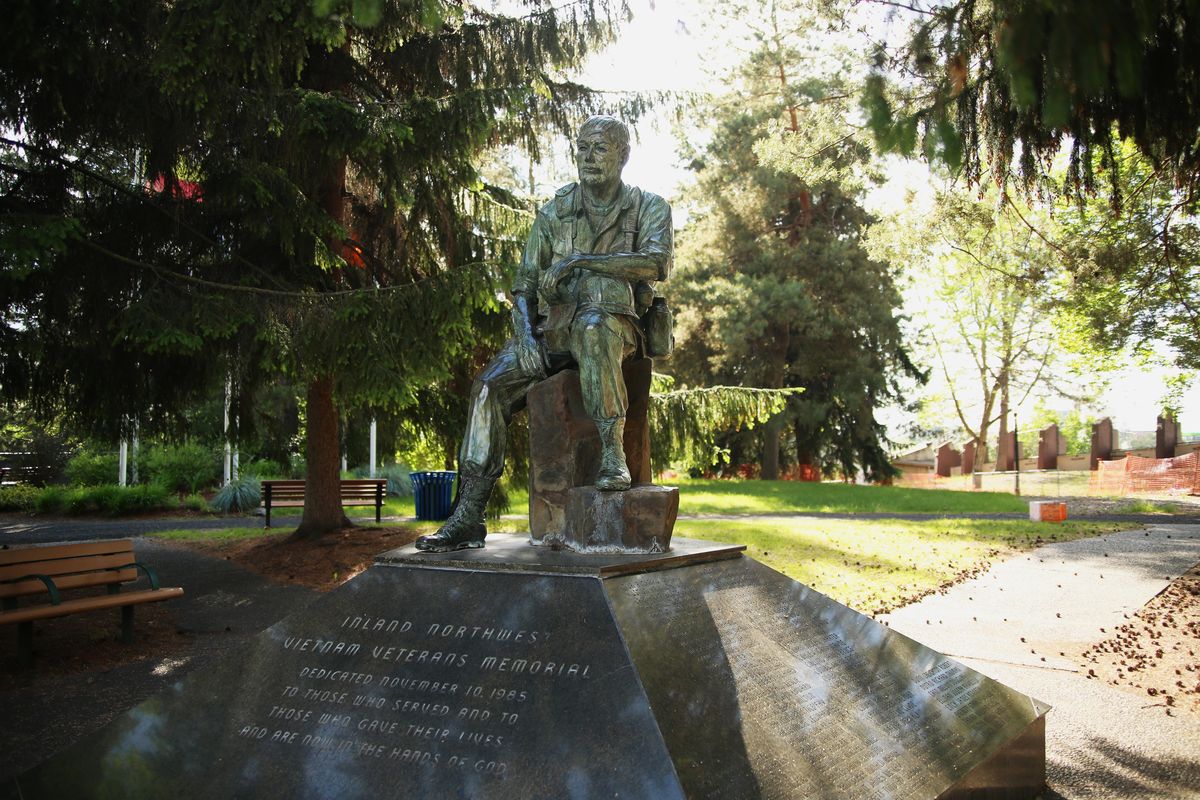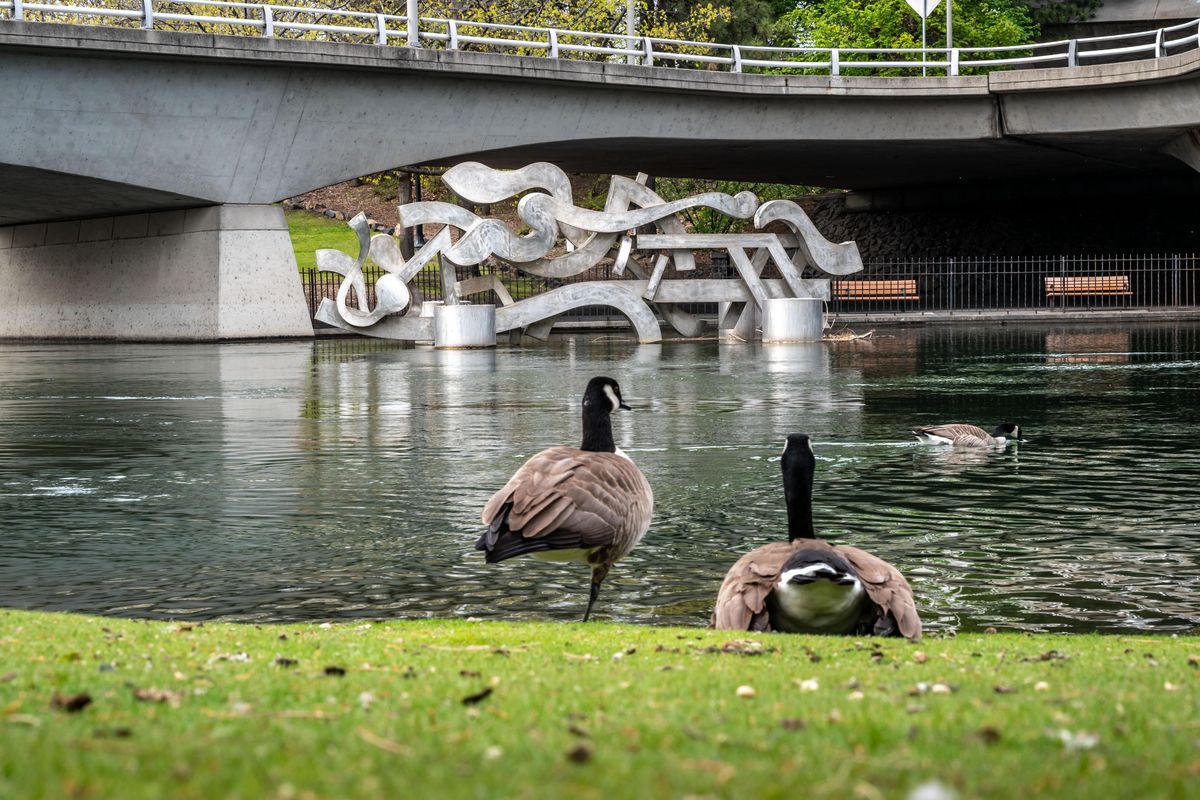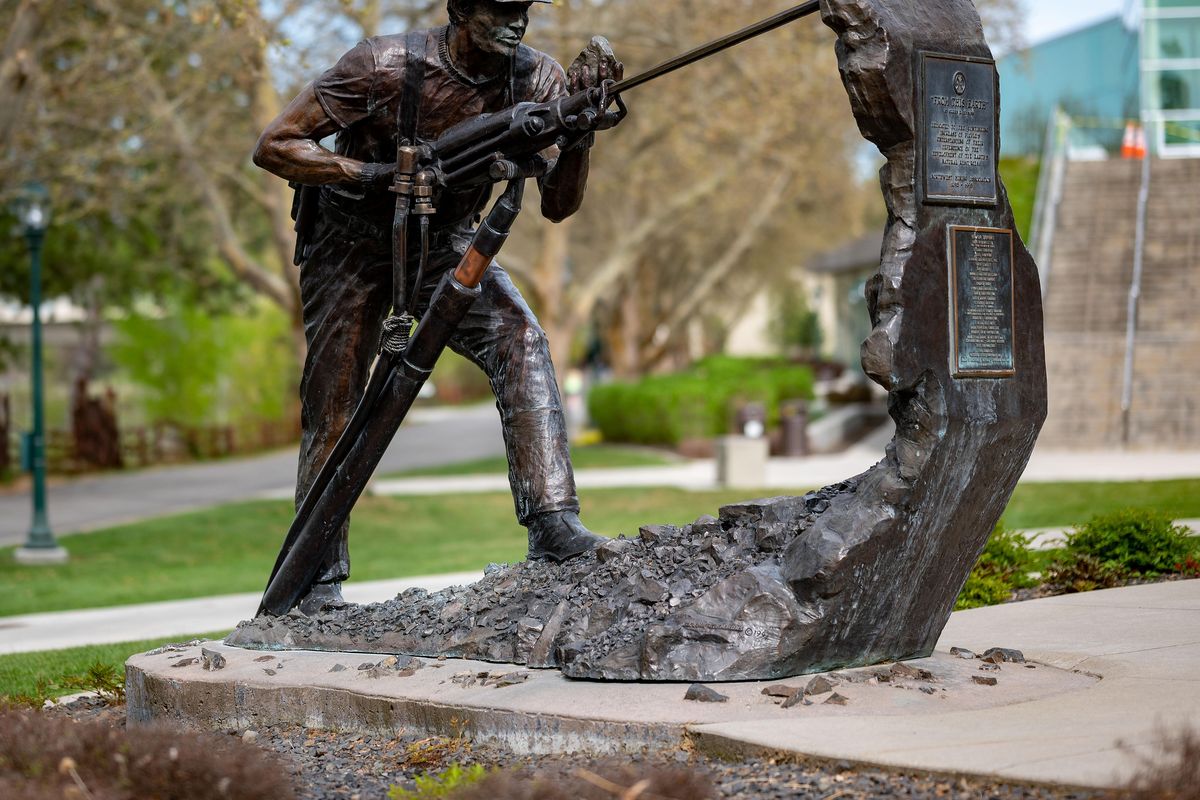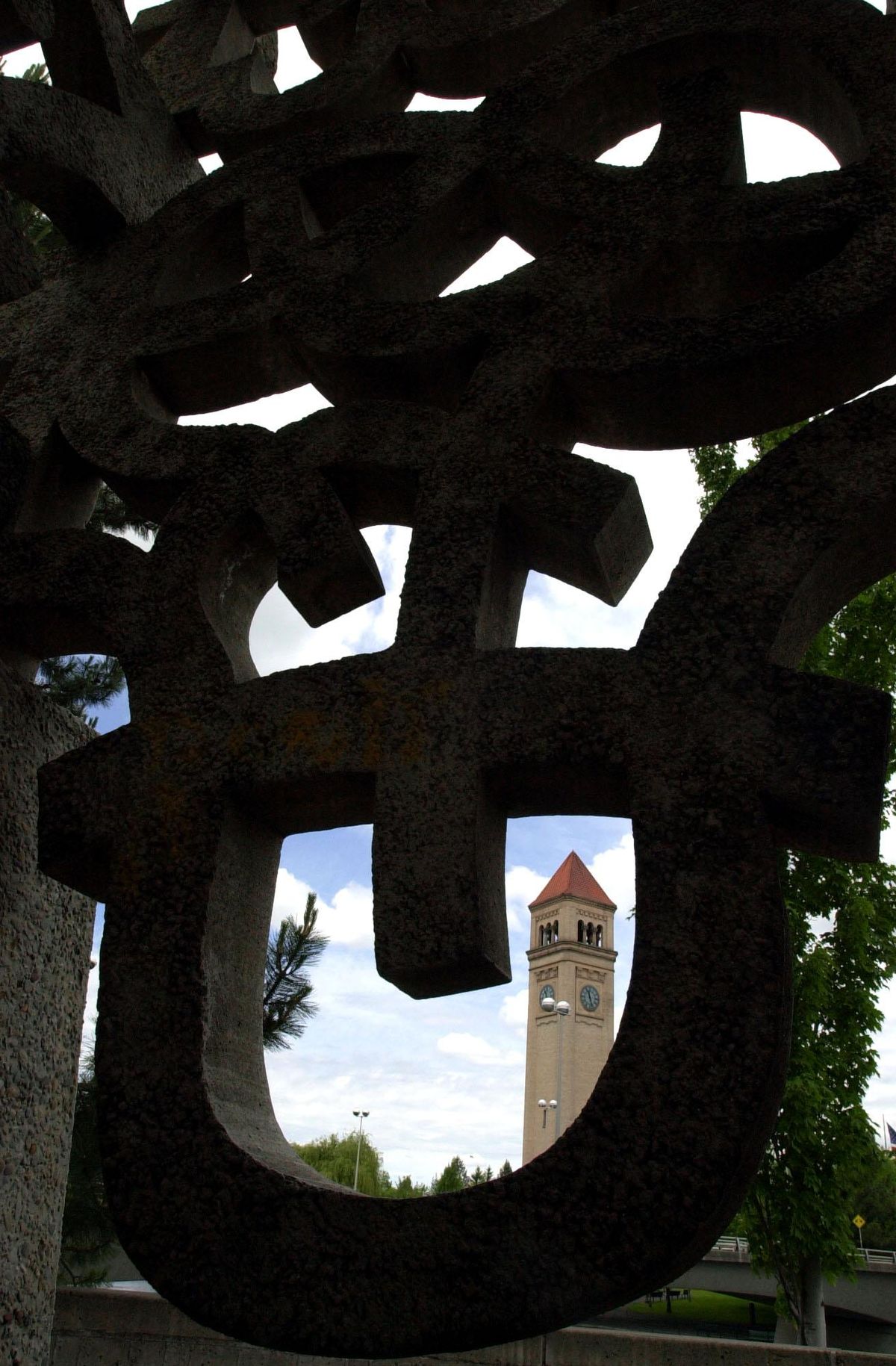There’s no better time for walking, bicycle tour of outdoor art in downtown Spokane, Kendall Yards

With galleries, restaurants, theaters and other art-displaying venues shuttered to maintain safe social distancing, public art in the great outdoors has never seemed so vital.
The sculptures that enliven our local paths have been carefully rendered by recognized artists for a variety of reasons. In conjunction with the city, some artworks were commissioned by our local and state arts organizations to commemorate events or honor residents, others to provide beauty or provoke feelings.
Viewing Spokane’s public art in the fresh air by foot or bike is a fantastic option for staying healthy while remaining engaged in something resembling civic life. And did we mention it’s free?
“I love thinking about those shared experiences of viewing public art between people,” said Melissa Huggins, executive director of Spokane Arts.
“That’s the beauty of experiencing art, in any form, whether you’re reading a book, listening to music, watching someone dance: You’re experiencing another person’s idea of what it means to be human, their unique point of view.
“Now is a great time to view the sculptures along the Centennial Trail.”
Travel solo so you can stop and stare at your own pace, or use the art-filled journey to engage the whole family with stories about Spokane’s cultural and historic past. There are more sculptures, plaques and murals strategically scattered in Spokane than most people can see in one day.
The following suggested public art walk is just one of the simplest routes to see a large number of public sculptures.
Here’s a link to a brochure of the sculptures by Visit Spokane and Spokane Arts: static.spokanecity.org/documents/riverfrontspokane/highlights/2020-sculpture-walk-brochure.pdf.
Here’s an online map that also includes murals and signal boxes: spokanearts.org/art-map/.
Also consider heading to Kendall Yards for a public art walk the neighborhood has designed at this link: kendallyards.com/wp-content/uploads/2015/05/Kendall-Yards-Art-Walk-Map-051315.pdf.
Rather than start in the middle of the sculpture show in Riverfront Park, pedestrians and bikers might find bigger rewards by beginning their art walk a little farther east on the Riverpoint Campus of Washington State University. There are several pieces thanks to the Washington State Arts Commission’s Art in Public Places Program, which was established by the legislature in 1974. Each time a new state building is constructed, one-half of 1%of the state portion of construction costs is used to acquire artwork for the building.
On the lawn east of WSU’s Nursing Building is a sculpture titled Alive Lively Living for Ramona Hodges by native Spokane artist Jim Hodges. The three stainless steel panels, each more than 6 feet tall and 4 feet wide, have multiple finishes and cutouts that reflect and distort whomever is viewing the massive pieces. It’s like a surprising and playful conversation with the landscape.
On the southeast corner of WSU’s Academic Building is Light Reading, a sculpture by Peter Reiquam, elevating the aesthetic of reading by placing indoor furniture in the open air along with lighted bookcases.
The towering columns of basalt that make up Cooperation by Michihiro Kosuge evoke the mysterious Stonehenge in England. They can be marveled at near the university’s Health Science and Interdisciplinary Design Institute.
Montana artist Patrick Zentz’s Riverpoint Observatory, located between the Eastern Washington University Center and the Academic Building, creates a protective stone arbor with the region’s topography etched into the glass ceiling.
Skipping ahead to the Centennial Trail along the river, walk west of the Riverpoint village condos to find a hammered copper rendition of Russian folk hero and general Shamil by Anatoli Abgudaev. Spokane’s sister city in Russia gave the sculpture to residents in 1991 as a reminder that peace is the best path.
Continuing west, an artist-made steel fence called Tapestry, welded with curves like rippling river water, hugs the trail for more than 1,000 feet. Bill and Karma Simmons created vignettes that populate their 2005 fence, including symbols of industry, the great Spokane fire, moose and more Spokane stories.
Farther west is From the Earth, a larger-than-life bronze by Glenn Emmons commemorating the Mining Association’s 100th birthday in 1995. The sculpture of a hard rock miner inspecting his ore is a reminder that Spokane has long been the headquarters for mining companies and a place of retirement for successful mining moguls.
Centennial Sculpture by Harold Balazs, 1978. An abstract aluminum sculpture which floats in the Spokane River. (Colin Mulvany / The Spokesman-Review)Buy a print of this photo
Local sculptor Ken Spiering, who produced the famed red wagon play structure in Riverfront Park, was commissioned to recognize the Sacred Heart Medical Center’s centennial in 1986. His sculpture titled The Call and the Challenge includes the figure of a Sister of Providence and honors the “health care pioneers.” This artwork serves as a timely reminder to thank our health care workers.
Take the first footbridge on the right to cross the river and approach the Lilac Bowl. Stone steps lead up the grassy slope to a Vietnam Veterans Memorial on which the names of local people who died in that war are carved. This serves as a quiet time to pay respect, a good teaching moment for kids about this particular war or a grim reminder that more Americans have lost their lives to the coronavirus than were killed in the Vietnam War.
Back down the steps is a great view of the Centennial Sculpture by Spokane’s most iconic artist, the late Harold Balazs. The 35-foot steel structure seems to float in the middle of the river like a tidal wave of organic undulation, as mysterious as the water itself. Just behind the sculpture, on land, is another Balazs original, his famous Untitled, later known as the Lantern Statue. The 20-foot monolith looks like a mammoth Chinese lantern with an array of geometric see-through cutouts up and down the concrete column.
This might be a good time in the art walk to consider Balazs’s own words. In an interview with Lloyd E. Herman, the artist said, “The one thing that runs through the work that I consider my most serious stuff is the idea of juxtaposing disparate ideas. This is a very complex world. This disparate quality of life in the world today – we need to start getting along with each other. I try to express that idea – disparate ideas can get along. And it’s nothing more complicated than that.”
Walk by the Clocktower and check out the wide flat expanse under the reconstructed Pavilion. Take in the sweeping views of the river and the power of the white water. Read the plaques about the Native Americans who fished the rivers for salmon. Remember what we have done to damage nature and the original residents of the land.
Take another foot bridge back across the water and notice how Spiering’s Childhood Express is fenced off so children won’t forget to socially distance. Turn west from the red wagon and walk toward the Looff Carrousel to smile at Sister Paula Turnbull’s whimsical Garbage Goat, a favorite of kids and adults alike since it first started vacuuming litter during Expo ’74.
Balazs’s and Bob Perron’s Rotary Riverfront Fountain will no doubt sprinkle screaming kids with water again one day, but for now it’s still an awesome sight to behold in quieter times.
Continue west in front of the ice ribbon to find David Govedare’s 1984 sculpture of metallic life-sized runners displaying The Joy of Running Together. Bloomsday, the largest timed road running race in the world, has been postponed for the first time in 44 years, but expect lots of Bloomies to post pics with these stiff runners come Sept. 20.
Walking east, on the way back to WSU campus, check out the abstract moon crater sculpture by Glenn Michaels created for Expo ’74. Notice the wood textures in the stone.
Between the performing arts center and concrete steps leading down to the water is an 8-foot bronze statue of fallen astronaut hero Michael P. Anderson by Dorothy Fowler. Anderson was the payload commander of the ill-fated Space Shuttle Columbia and a Spokane native. The Cheney High School and University of Washington graduate was one of seven crew members killed in 2003 when the space shuttle disintegrated upon re-entering the atmosphere. “Keeping This Dream Alive” is inscribed into the base of the statue, where he is depicted smiling and stretching his hand to release a dove into flight.
On the way back down the trail to the campus parking lots, notice the cherry trees are in bloom, the balsam roots are yellow, and it feels good to be alive.
As we wrestle with social isolation, there is comfort in knowing we can still enjoy shared cultural experiences with our community. We might not be able to talk to one another or sit next to each other, but in the great outdoors, we can find our own personal lines of sight to share art encounters together.










